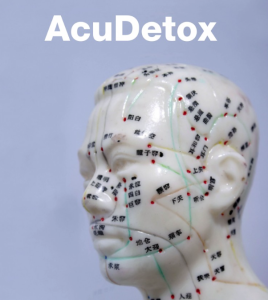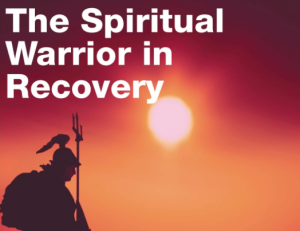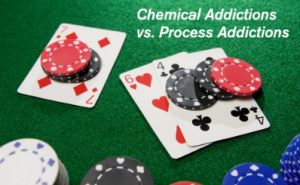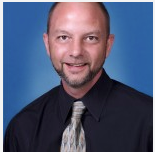Join us for this year’s Addicted to Comedy showcase on Saturday, October 3, 2015 celebrating Recovery Month. Headliner Jose Sarduy will be joined by comedians Shayla Rivera and Jay Lafarr for an entertaining evening at The Council on Recovery. All proceeds from this event will benefit the Sober Recreation Committee. Click here for more information and to register online.
Blog
Council Named #2 Best Local Charity
We are so grateful to have been named as the #2 Best Local Charity in Houston by the Houston A-List this Summer! Thank you to those who nominated and voted for us. We are truly honored to continue providing compassionate excellence at every level from our vast array of community programs and services to our team of devoted staff who interact with our clients and their families on a daily basis. Thank you, thank you!
AcuDetox
 By Marilyn Vache, MD, Medical Director at The Council on Recovery
By Marilyn Vache, MD, Medical Director at The Council on Recovery
Dr. Vache is a private practitioner specializing in integrative adult psychiatry, addiction medicine, and transcranial magnetic stimulation.
“They come in saying, I’m so nervous, I’m so nervous, I’m so nervous, but as soon as you treat them the group – they’re so calm — it gives me chills.”
That’s David Schrieber, LCSW, explaining his experience in administering acupuncture to clients in residential treatment at the Hicks Family Ranch in Buda. He and another AR counselor went to a workshop at the Academy of Oriental Medicine in Austin last year and, under the tutelage of Claudia Voyles, LCSW, took up the age-old practice of acupuncture for a very modern purpose.
Every Tuesday morning David, Claudia, and AOMA students treat 8 to 15 clients, inserting 5 acupuncture needles in each ear and leaving them in place for 15 minutes. Not everybody is comfortable with the idea, but once treated most clients return for more sessions. The idea is to manage PAWS, or post-acute withdrawal symptoms, an uncomfortable syndrome of anxiety and sleeplessness which can really distract clients in early recovery.
David’s goal is to provide the service even more often – three days a week. AcuDetox is provided at no additional cost to AR clients – something that would cost $40-60 per session in an acupuncture office. AR has provided it in earlier years and we are glad it’s back in our program. Even after years of positive research into its effectiveness however, it is still not well known or widely available. Just one more thing that makes AR so valuable in this community.
I first encountered acupuncture detox when I was in medical school and spent the summer of 1975 studying at the Haight-Ashbury Free Medical. The clinic adopted it soon after an acupuncturist in Hong Kong, Wen Hsaing-Leu, found that acupuncture points in the ear used for anesthesia also relieved symptoms of opium withdrawal. Research on 40 heroin and opium addicts appeared in Asian Journal of Medicine in 1973 and clinics in New York City and San Francisco adopted the practice. Since then we Westerners have adopted other Asian disciplines such as mindfulness and yoga as important supports to the work we do.
“We don’t claim it’s a cure for drug addiction. If we can treat the withdrawal symptoms, make the patient more comfortable, and alleviate their suffering, then we have achieved something. Our treatment is not the complete answer to drug addiction.” – Wen
The Spiritual Warrior in Recovery
By Rosemary Wentworth, MA, CGS, CAGS, CCDP-D, LCDC

Spirituality affects things of Spirit, which can be described as a person’s view on life. The practices and beliefs that one chooses to live by.
The Spiritual Warrior is a person who fights his self-ignorance. He is a person who struggles with improving his attitudes and behaviors. He is willing to discover the truth about reality. He is not fighting anyone else. He is placing distance between himself and his addiction and developing the qualities that will keep him in recovery.
Warrior means one who is brave and can see with his heart. The warrior commits to growing his heart and soul and becoming creative in decision and problem solving.
A Spiritual Warrior in Recovery travels the Path of Serenity, no matter what the chaos is outside of him, inside experiences peace. It becomes easier to have more meaningful relationships. Self- confidence grows with the passing of time. There is an emotional sobriety in which the Spiritual Warrior embraces life rather than isolating or feeling self-pity. He lives in the present moment without dwelling on the past or worrying about the future. He helps others with humbleness and this enjoyable and rewarding way to strengthen sobriety. There is an acceptance of whatever experiences come.
Process Questions
- How would you describe yourself as a Spiritual Warrior in your quest for Recovery?
- What qualities do you have that help you in your journey to recovery?
- What feelings and thoughts do you have when in the Spiritual warrior stance?
- What are the things that prevent you from moving forward?
- What advice would you give to a younger person in recovery who wants to take on this mantle of a Spiritual Warrior?
- What symbol would you create for yourself as a Spiritual Warrior?
What is a Warrior?

A Warrior is… Fearless, Confident, Strong Of Heart, Vigilant, Determined, Courageous, Knows How To Love and Hold Love, Courageous, Intelligent, A Leader, A Teacher, A Mentor, Brave, Skilled, Perseverance, Unflinching, Nimble, Lucid, A Searcher, Honorable, Willing To Help Another Person, Fearless, Knight of the Round Table, Follower of the Light, Grounded in A Spiritual Path, A Man of Character, Accountable, Masterful, A Mentor, A Planner, Eager To Develop Self, Continues to Stay Open to Growth, Nurtures Group Interaction, Uses Intuitive Intelligence, Confident, Generous, Loyal, Integrity, Empathetic, Resilient, Practices Meditation And /Or other Spiritual Disciplines, Validating, Authentic, Knows Self and Character Defects, Discerning, Relentless, Persistent, An Achiever, Fearless, Passionate, Brave, Honest, Humble, Honorable, A Fighter of the Truth, Diligent, Vigilant, Stands Tall, Does Not Surrender, A Man who Knows How To Use His Power Well, Focused, Devoted, Dedicated, A Guardian, A Sponsor, Focused, Practices at Being Skilled and Disciplined, Committed, A Visionary, protects His Sobriety, Willing To Fight For His Sobriety, Open To Learning, Uses Creative Visualization, Curious, Investigates, Gets Into the Solution, Leads By Example, Fair, Open To Feedback, Uses His Tools and Plans When He Needs to Get Onto Action, Grateful, Open to Self- Examination, Sincere, Connected to His Heart…
What is Hope?

Hope is… A Journey, Excelling, More, The Best Yet To Come, Better, Looking Forward To, Value, Pot of Gold, Just Around the Riverbank, Motive/Motivation, Unfinished Canvas, The Bigger Picture, Amends, Dreams, Determination, Ambitions, Willingness, Family, A Future Miracle, Puzzle Pieced Together, Joyous, Belief in a Future, Revelation, Fearless, Willing, Sobriety, Grace, Perseverance, Broken Chains, Optimism, Enlightening, Vision, Salvation, Forgiveness, Enthusiasm, Safety, Second Chance, Empowerment, LIFE !, Surrender, Happiness, Enthusiastic, Safety, Another Chance, Sunshine, Cared For, New Beginning with Higher Power, Concentration, Grateful, Fearless, Educational, Mercy, Foundational, A New Beginning, Faith, Belief in a Higher Power, Confident, Rainbows, Forgiveness, Advancement, Goal Fulfillment, Soul Fulfillment, Understanding, Goodness, Knowledge, Empowering, Dreams and Revelation, A Relieved Survivor, Determination, Angelic, Faithful, Joyful, Fulfilling, Peace, Belief, Freedom, Valuable, Valued, Value, Inspiration, Heart , Warmth, Optimistic, A Way Out, About Not Giving Up, Saying the Serenity Prayer, Still Being Loved, Comforting, About Being a Fighter, About Being a Survivor, Strong, Courageous, Brave, Giving, Positive, Light, Self Love, Vision, Prayer, Spiritual, Happy, About Not Giving Up, A new Day, Support Groups, Light At The End Of The Tunnel, Happiness For Others, Options, Stopping The Cycle for My Child, Opened Pathways, Spiritual Experiences, Independence, Willingness To Believe, Belief That Things Can Change…
What is Serenity?

Serenity is… Peace, Comfort, Love For Self, Happiness, Calmness, Acceptance, Belief, That You Can’t Control, The World,, Fulfillment, Sobriety, Experience, Livelihood, Humble, Understanding, Compassion, Welcoming, Joyous, Tranquility, Music, Nature, Calm, Peaceful, Curious, Botanical, Soft, Pleasurable, Love, A Garden, Cupids, The Wind And The Air, Worry Free, Forgiveness, Self-Acceptance, Belief, Wisdom, Serene, Meditative, Tranquility, Courage, Strength, Friendship, Healthy Boundaries, Meditative Restoration, The Passing Of The Storm, Lavender, Letting Go and letting God, Allowing Love Into My Life, The Wind In The Long Grass And The Fields, Calm, Energized, Accepting, Being here Now, Spiritual, Grace, Mystical, Interconnections, Self- Love, Beautiful, Inspired, NOW, Gently Flowing, Whole, Comfort, Enlightened, Gentle, Connection to Higher Power, Living For Life, Calm, Relaxing, Compassion, Kind, Humble, Stillness, Sobriety, Welcoming, Music, Understanding, Quiet, Natural, Oceanside, Within One Self, Love Gratitude, Acceptance, Loving, Gentle, Pleasant, trees, Water, Sky, At One With God, Surrendering, Pleasant, Sweetness, Honesty, Loving One Self, Heaven, Prayer, Solitude, Safety, Rainbows, God Consciousness, Joy, Hope, Natural Calm, Self Acceptance, Balance, Knowing My Beliefs and Values, Service, Courage, Curious, Courteous, Starlight Wisdom,, Soft, Pleasurable, An Orchid Garden, The Future, Flowers, Aromas, No More Obstacles, Clouds, Gliding, Broken Chains, Forgiving And Forgiven…
What is Spirit?

Spirit is… Unseen, Stamina, Full of Hope, Unbroken, Full of Energy, Truth, Teacher, Comforter, Merciful, Enlightened, Communication, Openness, Willingness, peace, Connection, Freedom, Inner Goodness, Love, Guiding, Honesty, Peace, Humble, Pure, Hungry, Free, Patient, Kind, Steadfast, Grounded, Hopeful, Enduring, Faith, Hope, Higher Power, Belief, Life, Relaxation, Meditation, Moving The Soul, Praise, Gratitude, Wisdom, Heart, Serenity, Compassion, Understanding, Kindness, Clairvoyant, Inspiring, Inner Self, Will Power, Peace of Mind, Power, Search for a Higher Power, Mystical, Giving, Of Value, Infinite, Always Present, Eternal, Stillness, Tolerance, Humble, Pure, Love, Tenderness, Simplicity, Bonding, Empathy, Depth, Lucidity, Epiphany, Simplicity, Humility, Trust, Consciousness, Refreshing, Uplifting, Sacred, Faith, Vulnerability, Healing, Awareness Growing, Playful, Belief, Heaven on Earth, Unseen, Transparent, Kind, Invisible, More Than meets The Eye, Inseparable, Unity, Compassion, Revealing, Deep, Togetherness, Present, Serenity, A Life Condition, Of the Light, Illuminating…
Chemical Addictions vs. Process Addictions
By Lorraine Saldivar, LCDC-I

First, it is important to understand that all addictions, chemical or process, affect the neuro-chemical reward and gratification system of the brain. The reasons a person initially starts using substances or begins a process may differ, but because the pleasure sensors in the brain receive a surge of dopamine, serotonin, oxytocin, and epinephrine, the brain perceives it as pleasurable and initially satisfying. This is the reason people keep coming back. When they come back again and again and again, the person can become addicted to the surge. Addiction happens when the brain goes from wanting these chemicals in order to “feel good” to needing them…and eventually will need more of them. This is what is known as tolerance and can happen in chemical and process addictions, with some variances. For example, when a person is addicted to crack cocaine, the person eventually needs more crack in order to feel the same level of high. However, with a porn addiction, for example the person does not need more porn, but rather different types of porn in order to satisfy the craving.
Something we see that is common in both chemical and process addictions is that consumers continue to use their drug of choice, or practice the rituals of their process addiction despite negative physical, relational, emotional, and sometimes legal consequences.
So why am I talking about this on a blog for a treatment center for drugs and alcohol? Well, it is not uncommon for us to find out a client that comes to us for treatment for a chemical addiction, also has, or has had a process addiction. Twelve Step support groups often warn people in recovery of the perils of cross addictions, and often people think only in terms of looking out for other chemicals. Because we know chemicals are often used as a maladaptive coping mechanism to deal with overwhelming feelings of anxiety, depressions, or to alleviate pain, people in recovery need to learn to identify addictive thought, behaviors and actions. For example, a person who turns to food for comfort may eat an entire pizza in order to cope with certain emotions. However, once the pizza is gone the person may then feel an overwhelming amount of shame and guilt and thus may turn to alcohol in order to “feel better” about over-eating.
A key component to helping people who may be suffering from one or both of these types of addiction is education. It is important to find out as much as you can and then to seek help either through treatment, support groups, counseling, prescribed medications (if warranted), or any combination of the these. Finally, it is important to know that the brain is a wonderfully powerful organ that can overcome any addiction and to know that there is ALWAYS hope!
Life Lesson in Co-Occurring Psychiatric and Substance Abuse Disorders (COPSD) or Dual Diagnosis
Today’s blog post was written by contributor Rick TreadwayTeran, former Director of Clinical Services at Austin Recovery. Rick writes about his life lesson in understanding, diagnosing, and helping those with co-occuring psychiatric and substance abuse disorders. Thank you for your contribution, Rick!
 I have been working with people in the helping field in some capacity since I was 18 years old. I worked as a cook, and later a nurse’s assistant, in a geriatric facility near my home. There was always a lot of discussion regarding medical and psychiatric diagnosis but at that time, people always just seemed like people to me. It didn’t matter if “Sam” was in a wheelchair, with dementia and had a low sodium diet as well as a catheter. He was one whole person who I had to accept and usually enjoyed caring for except for the angry bouts at night time bed routine. I later followed a path into psychology. There I learned some very big lessons. People were categorized based on illness. They were treated by one person for say Depression and another for addictions to pain killers. This is when I met “dual diagnosis” or, as the term now used “COPSD.” (A supervising psychiatrist told me once “When it becomes an acronym, it’s probably over diagnosed.”)
I have been working with people in the helping field in some capacity since I was 18 years old. I worked as a cook, and later a nurse’s assistant, in a geriatric facility near my home. There was always a lot of discussion regarding medical and psychiatric diagnosis but at that time, people always just seemed like people to me. It didn’t matter if “Sam” was in a wheelchair, with dementia and had a low sodium diet as well as a catheter. He was one whole person who I had to accept and usually enjoyed caring for except for the angry bouts at night time bed routine. I later followed a path into psychology. There I learned some very big lessons. People were categorized based on illness. They were treated by one person for say Depression and another for addictions to pain killers. This is when I met “dual diagnosis” or, as the term now used “COPSD.” (A supervising psychiatrist told me once “When it becomes an acronym, it’s probably over diagnosed.”)
The term is used when a person has a psychiatric disorder (or many), and a chemical dependency/abuse issue (or many). It used to be that Mental Health Professionals would not treat chemical dependency due poor outcomes and general poor progress. Later, chemical dependency counselors and facilities responded by rejecting people due to psychiatric impairments. As you can see, this resulted in a whole lot of people going untreated and ultimately rejected by helping systems. I was too young, naïve and probably just plain silly to know the difference….people were still people to me.
My internship started at a community based non-profit. A board member wanted me to work with his friend who was having a hard time. The board member brought Jose to my office and left him with me. Jose babbled, rotated, gyrated and cussed at about every other word. I was sure that this man was suffering from schizophrenia by the end of a very confusing hour. I referred the board member and friend to Psychiatry. “They won’t see him. They say it is because of his crack cocaine problem.” This guy also had HIV, and I didn’t even know the acronym for this many problems!!!
Please remember that I was naïve. My supervisor was a psychodynamic psychiatrist and allowed me great leeway!
I saw Jose for about 8 months. He had periods of confusion, fear, anger, homelessness and periods of trust, clarity and focus…sometimes all during the same session. His health went up and down. His drug use went up and down. I talked to him about 12 step meetings and took him to some of them. I always made sure they accepted people who were “wing-nuts.” I listened to his tortured pain and realized the great amount of factual information he was sharing with me. I began to understand his verbiage…all that broken communication and odd behaviors. His unkempt appearance projected self hate and rage. I understood his relapses and regressions back to crack. I supported him to get health care.
Eventually he trusted me enough to meet my supervisor and take meds, and then he just disappeared. I was dumbfounded. The Board member said he had gone homeless again.
A few years later, I was shopping at a local outdoor market, and a very tall Latino man in a large winter style hat (it was relatively temperate) reached out and touched me. I looked up, and it was Jose. Clean shaven, put together and smiling (Some dental decay left over from drugs and meds I assumed). He and I were both shopping for fresh produce. He hugged me and said, “Thank you for listening to me for so long back then. I was so crazy. I’m doing better now.” He informed me that he rents a room from the board member and lived at his home. He said the board member was very ill and that he was going to make him some fresh soup. He shared that he is taking his medication and that he doesn’t do drugs anymore. He was on social security (I assumed for mental illness and HIV). The smile he gave and tears in his eyes told me all I needed to know. Dual, Triple, COPSD….Jose was a real, living breathing soul that was now taking care of the board member that brought him to me from an alley. That is dual diagnosis treatment and care to me. Person first…then deal with diagnosis and multiple diagnoses. Mental health and substance abuse walk hand in hand and must both be addressed with care, stern objectivity and clinician tenacity. I am thankful that I was so naïve.
